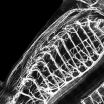(Press-News.org) PROVIDENCE, R.I. [Brown University] — Most proteins are shapely. But about one-third of them lack a definitive form, at least that scientists can readily observe. These intrinsically disordered proteins (IDPs) perform a host of important biological functions, from muscle contraction to other neuronal actions. Yet despite their importance, "We don't know much about them," said Wolfgang Peti, associate professor of medical science and chemistry. "No one really worried about them."
Now, Peti, joined by researchers at the University of Toronto and at Brookhaven National Laboratory in New York, has discovered the structure of three IDPs — spinophilin, I-2, and DARPP-32. Besides getting a handle on each protein's shape, the scientists present for the first time how these IDPs exist on their own (referred to as "free form") and what shape they assume when they latch on to protein phosphatase 1, known as "folding upon binding." The findings are reported in the journal Structure.
Determining the IDPs' shape is important, Peti explained, because it gives molecular biologists insight into what happens when IDPs fold and regulate proteins, such as PP1, which must occur for biological instructions to be passed along.
"What we see is some amino acids don't have to change much, and some have to change a lot," Peti, a corresponding author on the paper, said. "That may be a signature how that (binding) interaction happens."
For two years, the researchers used a variety of techniques to ascertain each IDP's structure. With I-2, which instructs cells to divide, they used nuclear magnetic resonance spectroscopy to create ensemble calculations for the protein in its free and PP1-bound form. They confirmed I-2's binding interaction with PP1 (known as the PP1:I-2 complex) with the help of small-angle X-ray scattering measurements at the National Synchrotron Light Source, located at the Brookhaven lab.
The researchers did the same thing to determine the structure of spinophilin and DARPP-32 in their free-form state and to gain insights into their shapes when they bind with PP1.
"It's analogous to putting a sack cloth over a person," Peti explained. "You can't see the details, but you can get the overall shape. This is really a new way to create a structure model for highly dynamic complexes."
INFORMATION:
Julie Forman-Kay, a senior scientist at the Hospital for Sick Children in Toronto and a biochemistry professor at the University of Toronto, is a co-corresponding author on the paper. Other authors include Barbara Dancheck and Michael Ragusa, Brown graduate students; Joseph Marsh, a graduate student at the University of Toronto; and Marc Allaire, a biophysicist at the Brookhaven lab.
The U.S. National Institute of Neurological Disorders and Stroke, the Canadian Institutes for Health Research, the Natural Sciences and Engineering Research Council of Canada and the U.S. National Science Foundation Graduate Research Fellowship program funded the research.
Brown-led research divines structure for class of proteins
2010-09-08
ELSE PRESS RELEASES FROM THIS DATE:
New compound safely reduces plaques in mouse model of Alzheimer's disease
2010-09-08
A new study identifies molecules that can be used to selectively reduce generation of the sticky, neuron-damaging plaques that are the hallmark of the Alzheimer's disease (AD) brain. The research, published by Cell Press in the September 9 issue of the journal Neuron, may lead to the development of effective and safe therapeutics for this currently incurable disease.
Previous research has suggested that an alteration in brain levels of amyloid ? proteins (A?) plays a major pathogenic role in AD, a devastating neurodegenerative disorder that causes progressive cognitive ...
Brain mechanism linked to relapse after cocaine withdrawal
2010-09-08
Addictive drugs are known to induce changes in the brain's reward circuits that may underlie drug craving and relapse after long periods of abstinence. Now, new research, published by Cell Press in the September 9 issue of the journal Neuron, uncovers a specific neural mechanism that may be linked to persistent drug-seeking behavior and could help to guide strategies for development of new therapies for cocaine addiction.
Previous research has shown that the ventral tegmental area (VTA) is a brain region that is activated when cocaine users experience a craving for cocaine ...
Single gene regulates motor neurons in spinal cord
2010-09-08
New York (September 8, 2010) – In a surprising and unexpected discovery, scientists at NYU Langone Medical Center have found that a single type of gene acts as a master organizer of motor neurons in the spinal cord. The finding, published in the September 9, 2010 issue of Neuron, could help scientists develop new treatments for diseases such as Lou Gehrig's disease or spinal cord injury.
The "master organizer" is a member of the Hox family of genes, best known for controlling the overall pattern of body development. By orchestrating a cascade of gene expression in ...
Compounds fend off Alzheimer's disease amyloid pathology
2010-09-08
A team of scientists, led by University of California, San Diego School of Medicine researchers, has synthesized hundreds of new compounds with the potential of reducing the production of the A-beta 42 peptide, a primary component of Alzheimer's disease (AD).
In mouse models, one tested compound specifically reduced levels of A-beta 42, which is believed to be responsible for the destruction of neurons, but left other essential enzymatic activities in the brain unaffected, said Steven Wagner, PhD, a project scientist in the UCSD Department of Neurosciences.
The ...
Extreme X-ray source supports new class of black hole
2010-09-08
A group of international astronomers in the UK, France and the USA, led by the University of Leicester, have found proof to confirm the distance and brightness of the most extreme ultra-luminous X-ray source, which may herald a new type of Black Hole.
The X-ray source, HLX-1, is the most extreme member of an extraordinary class of objects – the ultra-luminous X-ray sources – and is located in the galaxy ESO 243-49 at a distance of ~300 million light years from the Earth.
The astronomers' findings confirm that the extreme luminosity (which is a factor of ~100 above ...
MIT researchers find that interneurons are not all created equally
2010-09-08
CAMBRIDGE, Mass. – A type of neuron that, when malfunctioning, has been tied to epilepsy, autism and schizophrenia is much more complex than previously thought, researchers at MIT's Picower Institute for Learning and Memory report in the Sept. 9 issue of Neuron.
The majority of brain cells are called excitatory because they ramp up the action of target cells. In contrast, inhibitory cells called interneurons put the brakes on unbridled activity to maintain order and control. Epileptic seizures, as well as symptoms of autism and schizophrenia, have been tied to dysfunctional ...
Neurogenetic studies show proprietary compound reduces brain plaques linked to Alzheimer's
2010-09-08
SAN DIEGO -- In the Sept 9, 2010 issue of Neuron, Neurogenetic Pharmaceuticals, Inc. (NGP) reports proof of concept studies that show its proprietary compound, NGP 555, is effective in preventing the amyloid pathology of Alzheimer's disease (AD) in a transgenic mouse model. The study further demonstrates that following chronic treatment with the gamma secretase modulator (GSM) compound from NGP, the mice were devoid of gastrointestinal side effects, an adverse finding commonly associated with gamma secretase inhibitors (GSIs).
A major pathological hallmark of Alzheimer's ...
Use of informatics, EMRs enable genetic study of vascular disease
2010-09-08
Scientific research published in the current issue of the Journal of the American Medical Informatics Association (JAMIA) reports on a study of genetic variants that influence human susceptibility to peripheral arterial disease (PAD), made possible by leveraging electronic medical records (EMRs; also called EHRs or electronic health records). A team of authors from the Mayo Clinic Divisions of Cardiovascular Diseases and Biomedical Informatics and Statistics conducted the study and concluded that EMR-based data, used across institutions in a structured way, "offer great ...
NOAA designates the eastern North Pacific basking shark a 'species of concern'
2010-09-08
NOAA's Fisheries Service has designated the eastern North Pacific basking shark, a "species of concern" because it has suffered a dramatic decline in population despite decreasing fishing pressure. The label "species of concern" may be given to a species when there are concerns regarding the population status.
The eastern Pacific basking shark is not being considered for listing pursuant to the Endangered Species Act, rather it is a species of concern because it has been over fished and its population has apparently not responded to conservation measures implemented ...
Brain cells determine obesity -- not lack of willpower: Study
2010-09-08
An international study has discovered the reason why some people who eat a high-fat diet remain slim, yet others pile on the weight.
The study, led in Australia by the Monash Obesity and Diabetes Institute (MODI) at Monash University, found a high-fat diet causes brain cells to become insulated from the body preventing vital signals, which tell the body to stop eating and to burn energy, from reaching the brain efficiently.
MODI director and Australian Life Scientist of the Year Professor Michael Cowley said there were two clear outcomes from the findings.
'We discovered ...



